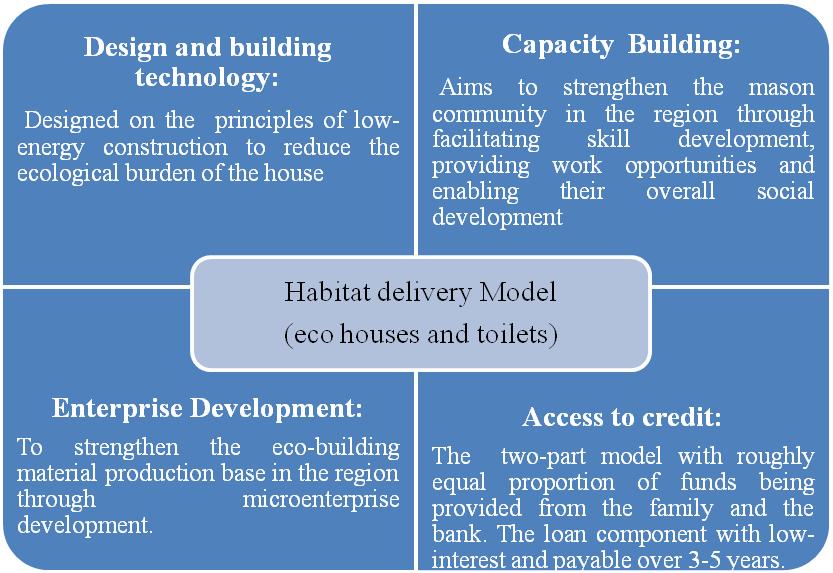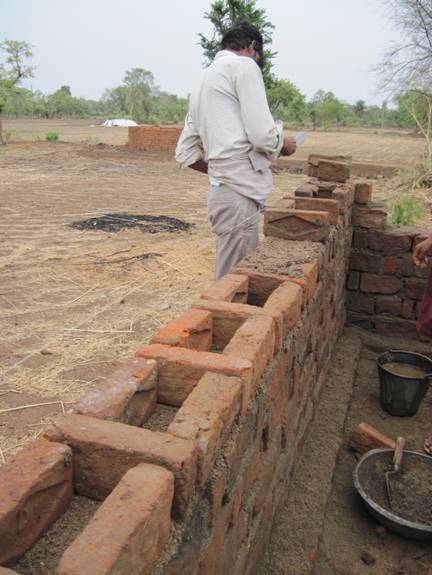|
Small Steps, Big Achievements: R ight to shelter is a fundamental human right and housing is a basic requirements for human survival. The Governments, both at the central and the state levels, have recognised this. ‘Shelter for all’ finds its place even in India’s vision 2020. While on the one hand, rapid increase in population and cost of construction is widening the gap between the rich and the poor, on the other hand, rising aspirations are pushing rural communities to opt for energy intensive and ecologically damaging building materials. Though one should keep in mind environmental concerns such as natural resource degradation, environmental pollution, climate change etc, the challenge at present also involves providing adequate and safe housing for people without access to housing. It is observed that rural poor are neither aware of various housing schemes nor is there a transparent public process to address this issue. Also, due to the fact that most of the rural families find it difficult to invest money for construction of house, the credit mechanism (which enables the disadvantaged rural families to accesses adequate and safe housing) has become one of the most important components of the habitat delivery model.
Figure 1.1: Need for Eco House Delivery Model Thus, housing delivery models are required that facilitate "processes for sustainable habitat development" in villages of India. These processes need to address concerns of energy and resource efficiency in construction; delivery mechanisms that support and enhance local skills and economies; and development of durable and safe habitat in response to local climate and geomorphological conditions. This is being addressed by Development Alternatives through FEM 1 project which is funded by FEM Italia Onlus.
Figure 1.2: Key action areas of Habitat Delivery Model for FEM Need for FEM In India, only a small
percentage of rural housing is financed by grant-based government social
housing schemes. Most housing is constructed incrementally by families
themselves in an informal manner. Observation shows that government
housing schemes and projects have had a poor record in improving habitat
quality in long term despite the potential for comprehensive influence.
A majority of rural poor still suffer on account of inadequate housing,
lack of infrastructure and poor access to knowledge, material and
financial resources. There is a significant lack of institutional
finance for rural housing. Though the institutional infrastructure,
particularly the banking sector, has acquired a reasonable depth in the
rural areas, they continue to be hesitant in extending housing loans to
the rural borrowers on account of various constraints and challenges
associated with rural lending. Further, in the absence of necessary
flexibility in application of prudential norms, the lending agencies
tend to keep away from such lending. As a result, the availability of
institutional credit for rural housing and its accessibility by the
rural population continue to be serious challenges and most of the time
these people depend on loans/credit from sahukaar or mahajan
at high interest rates, adding further to their impoverishment. As a reaction to this, the main focus of DA’s Rural Habitat programme is to provide support to delivery of cost effective and energy efficient building products and services for rural communities through micro-entrepreneurs and artisans. The programme facilitates demand creation for their products and services through social marketing, government schemes and credit linkage or micro financing. Eco Habitat Delivery Model The project called the ‘Micro entrepreneurial models and services for the socio-economical development of working poor in India’2, supported by FEM, is an action research project and a part of larger Rural Habitat Programme of DA and is designed to set in place a comprehensive model for housing and habitat delivery for rural families in selected regions of Bundelkhand with the aim of filling the following gaps: • The unavailability of bridging funds for eco construction that can provide incentives to the rural poor to adopt environment friendly materials • Inadequate demonstration of eco friendly technology options in the villages • Lack of securitisation of micro-loans for the poor that can help catalyse demand for eco construction. The central aim of the initiative is to facilitate the implementation of a sustainable habitat delivery model for the rural community, in the socio-economic context of Bundelkhand. In the first phase the primary objective of the project was to set in place a delivery and financing model which enables the rural families to access durable shelter and adequate sanitation. Project Deliverables for the three year project include 100 eco houses, 200 eco toilets, establishment of two enterprises related to eco building material production, and capacity building of 30 building artisans and four supervisors. Eco technologies being used in the project are rat-trap bond for brick masonry, precast door window frames, micro concrete roofing (MCR) tiles for verandah and toilets, and stone patti roofing for room and kitchen. Financial model The estimated cost of the eco house construction in this project is Rs 60,000. Half the amount would comprise of bank loan and half will be the contribution from the clients or families in the form of material and labour. In case of construction of eco toilets, the estimated cost is Rs 8500 out of which Rs 2200 will be leveraged from a government scheme, namely the Total Sanitation Scheme, Rs 5500 will be the bank loan component and Rs 800 will be the clients’ contribution. Key outcomes • Clear understanding of the processes involved and the strategies to be adopted in bank linkage for access to loans • Favourable financial delivery model for the beneficiary finalised with the bank • Promotion of eco-friendly building materials and technology • Good working relationship with Government of Madhya Pradesh which may help in developing a housing scheme, which can converge with this financial model in an effective way • Leveraging with government schemes such as Mukhya Mantri Gram Awas Yojana and Total Sanitation Scheme for eco house and toilet construction q Amol Mangrulkar References Endnote
|


